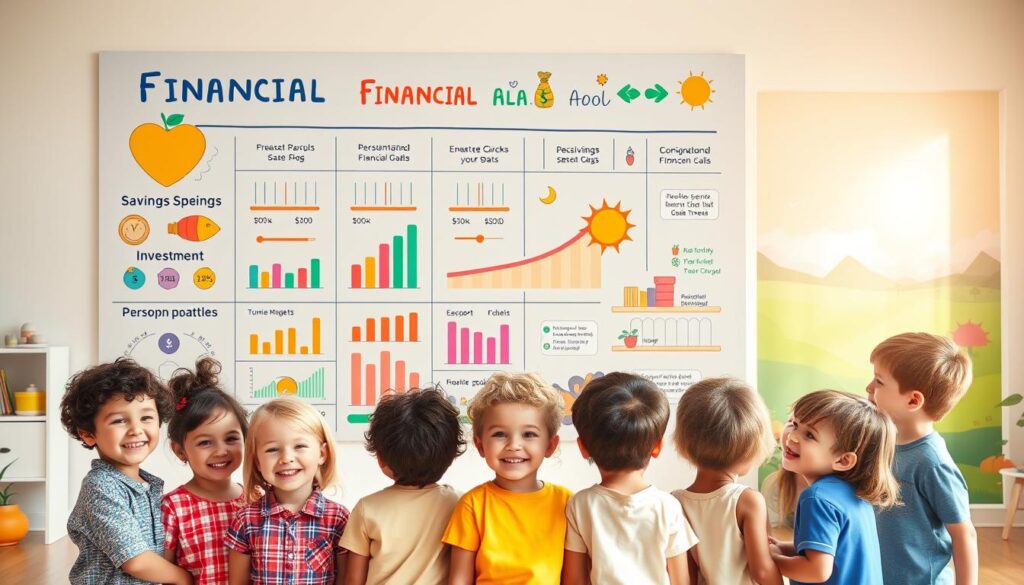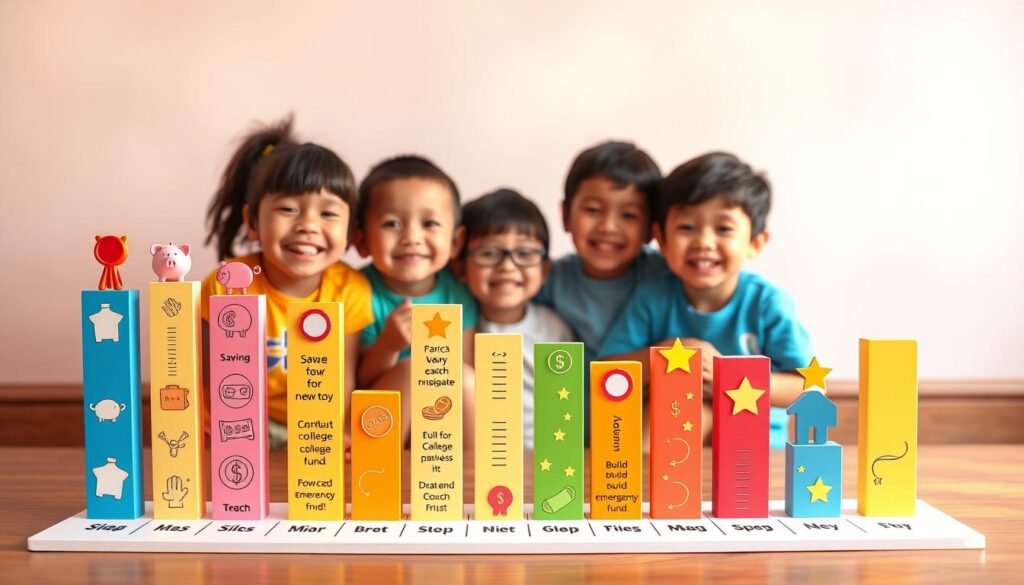I’m really excited to share my journey with you. It’s about managing my allowance and making a personal money goals chart. I’m 12 and own AssetsForKids. I’ve learned a lot about making my financial goals real.
Having a clear plan helps me stay on track. It helps me make smart choices about my money management. Resources like Student Printables and Mona’s Budgeting Adventure workbook have changed the game for me.
By making my own chart, I can see my goals. It’s a great feeling to know I control my money.
In this article, we’ll talk about making your own financial goals chart. You’ll learn to manage your allowance like a pro!
Why I Started Setting Money Goals (And Why You Should Too!)
Setting money goals changed my life. It can change yours too. Learning to manage money showed me how important goals are. It’s like having a map for your money path.
Teaching kids about money starts with setting goals. It’s not just saving. It’s about what you want to buy or save for. Having a goal helps you stay on track.
Kids’ financial literacy is key today. Setting goals taught me to spend and save wisely. Every dollar has a purpose. A money goals chart helped me track my progress. It made reaching my goals exciting.
Setting money goals gives you direction and motivation. Knowing your goal makes money decisions easier. For example, saving for a toy makes you want to save your allowance.
- Identify what you want to achieve with your money.
- Create a plan to reach your goals.
- Track your progress regularly.
- Stay motivated by celebrating small victories along the way.
Follow these steps and keep your financial goals clear. You’ll develop habits that last forever. Start setting your money goals today and see how it changes your life!
Building Your Kids Money Goals Chart: My Simple Method
My simple method for building a kids money goals chart is fun and engaging. It makes learning about money exciting.
First, pick the best chart type for your child. You must decide between a digital or paper chart.
Digital vs. Paper Charts: Which One I Like Better
Digital charts are easy to use and update. They’re great for kids who love technology.
Paper charts, on the other hand, are hands-on. Kids can color and draw on them.
- Digital charts can be made with software or apps for kids.
- Paper charts can be simple or use a workbook like Mona’s Budgeting Adventure.
I like digital charts for their ease. But, kids really enjoy making paper charts.

It’s important to make your chart look good, no matter the type. Pictures and colors make it fun for kids.
- Use pictures or icons for savings goals, like toys or fun activities.
- Use your child’s favorite colors to make it personal.
- For digital charts, use digital stickers or emojis to show progress.
- For paper charts, let your child decorate with markers or crayons.
By making the chart fun and interactive, your child will want to reach their money goals.
Using resources like Mona’s Budgeting Adventure workbook can help. It offers a structured way to create a great kids money goals chart.
Setting Awesome Money Goals That Actually Work
To make the most of your allowance, you need to set awesome money goals. Setting financial goals is exciting. It’s about saving money and planning for your dreams.
When setting your financial goals, make sure they are achievable and align with your values. You might want to save for a new bike or college. Make your goals SMART: Specific, Measurable, Achievable, Relevant, and Time-bound.
My $10 Rule for Quick Wins
Start achieving your financial goals with my “$10 Rule.” Whenever you get your allowance, save $10 for your goal. It might seem small, but it adds up and feels great.
Here’s how you can use the “$10 Rule” for different goals:
| Goal | Total Amount Needed | Time to Achieve |
|---|---|---|
| Saving for a $100 toy | $100 | 10 weeks |
| Saving for a $500 bike | $500 | 50 weeks |
| Saving for a $1000 savings bond | $1000 | 100 weeks |
For more tips on setting financial goals, check out this article. It has tips on milestones, benchmarks, and goals for kids’ money management.
By following these steps and using the “$10 Rule,” you’ll reach your financial goals. Remember, be consistent and patient. Your money goals are within reach!
Tracking Your Progress and Staying Excited
Tracking your money progress is key to reaching your goals. I’ll show you how to do it in a fun way. It’s like having a map for your money journey!
Use a chart or journal to track your progress. You can make a simple chart or use a mobile app. Write down your goals and mark them off as you reach them. Seeing your progress can really motivate you.
Here are some ideas for tracking your progress:
- Create a colorful chart with columns for your goals, progress, and achievements.
- Use a habit tracker app to monitor your savings and spending habits.
- Keep a journal to write down your thoughts, successes, and challenges.
Celebrate your successes too. When you hit a milestone, treat yourself. This keeps you excited about your money journey. For example, celebrate each month you save for a new bike.

- Have a small party with family or friends.
- Do something you’ve been wanting to do, like going to a movie or playing a game.
- Save a special reward for when you reach a major milestone.
Tracking your progress and celebrating your wins keeps you motivated. Remember, the journey to financial literacy is just as important as the goal!
Conclusion: Your Money Journey Starts Today!
Starting a kids money goals chart is the first step in your financial journey. It helps you set goals and track your progress. This tool makes learning about money fun and helps you manage it well.
It’s important for kids to learn about money today. They can start understanding its value early. A kids money goals chart helps them see their goals and stay motivated.
Following the tips in this article will help you succeed with money. Remember, everyone’s journey is different. It’s okay to make mistakes. The key is to start and keep moving towards a better financial future.